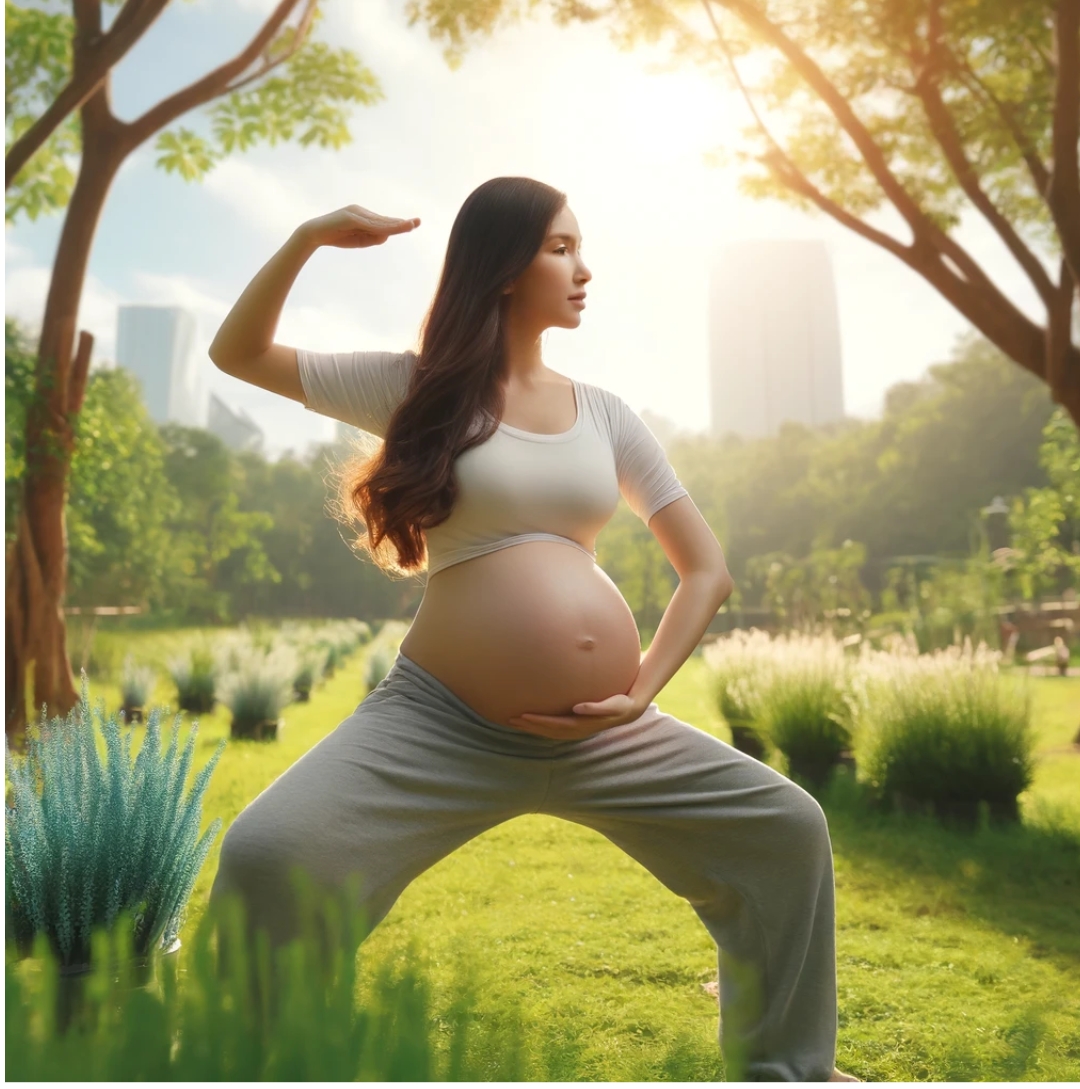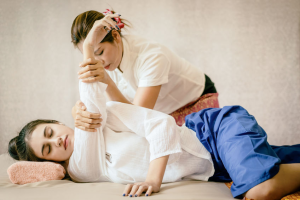
Tai Chi, an ancient Chinese martial art known for its slow, deliberate movements and deep breathing, has evolved over centuries into a graceful form of exercise that’s now praised for its health benefits for people of all ages and life stages. With its origins tracing back to the 12th century, Tai Chi combines elements of meditation, controlled movements, and deep breathing to enhance physical and mental well-being. Originally developed for self-defense, Tai Chi is now appreciated as a therapeutic practice, promoting balance, flexibility, and peace of mind.
For expectant and new moms, Tai Chi offers a unique approach to maintaining wellness before and after childbirth. Prenatal and postnatal wellness encompass not only physical health but also emotional and mental well-being. During pregnancy, a woman’s body undergoes significant changes that can cause stress and discomfort. Postnatally, the body needs to recover, and new moms must adapt to the challenges of motherhood. Tai Chi’s gentle movements are ideal for nurturing the body and mind throughout this transformative period.
The Benefits of Tai Chi for Expectant Mothers
Practicing Tai Chi during pregnancy brings numerous benefits to expectant mothers. Improved physical health and mobility are among the top advantages. Through its low-impact exercises, Tai Chi enhances muscle strength, flexibility, and balance. It’s an activity that helps manage common pregnancy issues like swelling and joint pain, since the movements aid in circulation and the gentle stretching reduces tension. Tai Chi can also prepare the body for childbirth by improving muscle tone and endurance.
Stress reduction and emotional well-being are also significant benefits of Tai Chi for pregnant women. Pregnancy can be a time of heightened emotions and stress, leading to anxiety and depression in some women. Tai Chi promotes a sense of calm and relaxation, thanks to its meditative nature and focus on deep breathing. This mindfulness can reduce stress hormones in the body and foster a tranquil environment for both mother and baby. Additionally, Tai Chi provides a mental break from the preparations and concerns of impending motherhood, offering a serene space to focus on oneself and the baby.
Tai Chi’s Role in Postnatal Recovery
After giving birth, women embark on the road to recovery, seeking to regain their pre-pregnancy strength and well-being. Tai Chi is a fantastic way to support physical rehabilitation post-birth. It’s low-impact yet effective in rebuilding core strength and pelvic floor muscles, both of which are crucial after delivery. Additionally, because Tai Chi involves the entire body, it helps new moms regain overall body strength at a comfortable pace.
Emotional and mental health support during the postnatal period are equally important. New mothers can feel overwhelmed, and the gentle practice of Tai Chi provides a peaceful retreat. The focus on mindfulness and controlled breathing can ease postpartum depression symptoms and help mothers manage the emotional rollercoaster that may ensue after childbirth. Equally important, Tai Chi offers a community of practitioners that can serve as a support network, a critical element for new moms seeking connection and shared experiences.
Safety Considerations for Tai Chi During Pregnancy
Even though Tai Chi is a low-impact exercise, safety considerations are paramount for pregnant women engaging in any physical activity. Precautions for prenatal Tai Chi practice include avoiding any movements that involve jumping, sudden turns, or risk of abdominal impact. It is also important to practice Tai Chi in a cool, well-ventilated space to avoid overheating and to stay hydrated throughout the session.
Consulting with healthcare providers before starting or continuing a Tai Chi regimen during pregnancy is also essential. They can offer personalized advice and highlight any specific risks based on individual health profiles and pregnancy progression. They might also provide recommendations on which movements to avoid and how to tailor Tai Chi practice to benefit prenatal health most effectively.
Adapting Tai Chi Movements for Pregnancy
As a woman’s body changes during pregnancy, it’s necessary to adapt Tai Chi movements to accommodate her growing belly and shifting center of gravity. Modifications for each trimester ensure that Tai Chi practice remains safe and comfortable. For instance, in the second and third trimesters, wider stances may be adopted to provide better balance, and twisting motions should be minimized to avoid undue pressure on the abdomen.
Gestational milestones and exercise adjustments go hand-in-hand, as certain Tai Chi exercises can be particularly beneficial at different stages of pregnancy. For example, movements that promote pelvic flexibility and strength can be emphasized as the due date approaches. This adaptive approach ensures that the mother-to-be gains the most from her Tai Chi practice without compromising safety or comfort.
Learning Tai Chi: Getting Started for Expectant Moms
For expectant mothers wanting to learn Tai Chi, choosing the right Tai Chi style and instruction is crucial. Multiple styles exist, each with its unique movements and pace. Pregnant women might find the slow and gentle forms more accommodating, such as the Yang or Sun styles. It’s important to find an instructor experienced in teaching pregnant women, ensuring that the movements fortify wellness without overexertion.
Setting goals and establishing a routine can also maximize the benefits of Tai Chi. Initial goals might include achieving relaxation, improving balance, or gently increasing muscle strength. Consistent practice, whether daily or a few times a week, can instill a routine that provides structure and ongoing support throughout pregnancy. Over time, these goals can evolve, guiding mothers through a personalized journey of self-care and awareness.
Tai Chi Lessons and Practice Flow for Prenatal Wellness
For prenatal wellness, Tai Chi lessons encompass a well-rounded practice that starts with warm-up and cool-down techniques. Warming up the body is essential to prepare muscles and joints for the session, while cooling down allows for a gradual return to normal activity, preventing any undue strain or muscle stiffness.
Fundamental Tai Chi movements and postures are then practiced, focusing on smooth transitions and controlled breaths. These movements—like Wave Hands like Clouds or Parting the Wild Horse’s Mane—encourage total body harmony and can be adapted to the expectant mother’s capabilities. Breathing techniques and mindfulness are deeply integrated into Tai Chi practice, encouraging a calming and centered experience that benefits both the mother and the developing fetus.
Integrating Tai Chi into Postnatal Life
Resuming Tai Chi after childbirth can be a gentle and effective way for new mothers to embark on their recovery journeys. As the body heals, Tai Chi can be incrementally reintroduced, starting with simpler movements and gradually increasing complexity as strength and endurance permit. It is recommended to wait until a healthcare provider gives the clearance to resume physical activities and then to listen intently to the body’s signals during practice.
Incorporating a baby into Tai Chi practice can be a delightful way to bond while fostering wellness. Holding the baby during certain Tai Chi poses or practicing in their presence can be calming for both mother and child. It can also introduce the child to an environment of mindful movement and peacefulness from an early age, which may have long-term developmental benefits.
Resources and Support for Tai Chi Practitioners
Finding local Tai Chi classes and instructors suited for pregnant and postnatal women can sometimes be a challenge, but many communities offer specialized classes. Some may even be targeted specifically toward maternal health. Local wellness centers, community bulletins, or maternity clinics can be great places to inquire about such classes.
Online Tai Chi lessons and community forums also provide valuable support, especially for those who may not have access to local classes or prefer the convenience of learning from home. These platforms can offer step-by-step guidance and connect practitioners to a broader Tai Chi community, allowing them to share experiences and advice with other expectant and new mothers.
Conclusion: Embracing Tai Chi as a Lifetime Practice
The practice of Tai Chi offers long-term benefits for both mother and child, promoting physical strength, flexibility, and mental resilience that can serve well beyond the years of pregnancy and early motherhood. It is an activity that can grow with a family, adapting over time to meet changing needs and capabilities.
The journey of continuous learning and practice in Tai Chi is one of its most appealing aspects. As expectant and new moms delve into the gentle art, they enrich their lives and nurture their well-being. Embracing Tai Chi is more than just a form of exercise; it’s an investment in a balanced, harmonious lifestyle that can become a treasured part of family health and a legacy of well-being passed down to the next generation.





